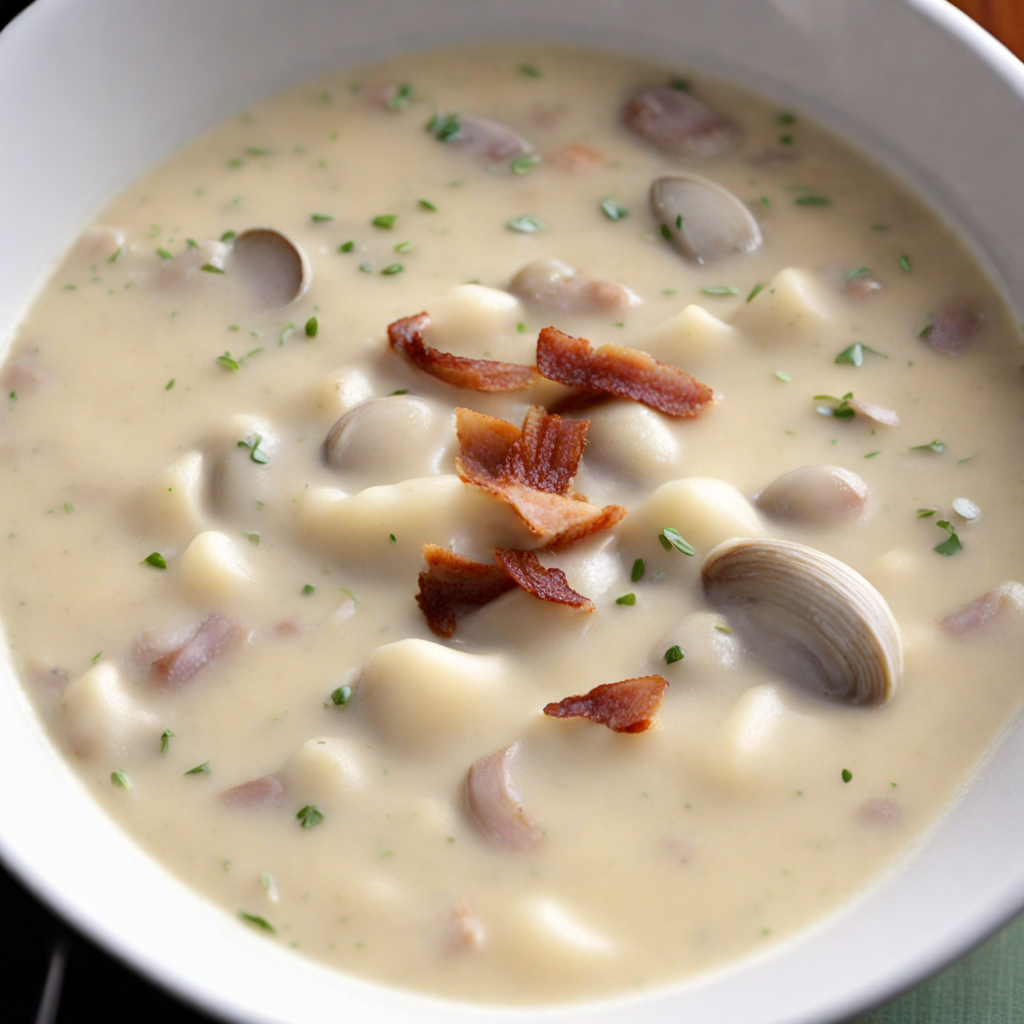Clam Chowder
Clam chowder is a rich and creamy soup that hails from the northeastern region of the United States, particularly associated with New England. This comforting dish is primarily made with tender clams, which provide a briny sweetness that beautifully contrasts the velvety base. The classic New England clam chowder typically features a combination of diced potatoes, onions, and sometimes celery, all simmered in a luscious broth made from milk or cream. The use of butter and flour to create a roux adds depth and richness to the texture, making each spoonful a delightful experience. The flavor profile of clam chowder is a harmonious blend of savory and slightly sweet notes. Fresh clams are often enhanced with seasonings like thyme, bay leaves, and black pepper, giving the soup a complex taste that warms the soul. The potatoes add heartiness, while the creaminess brings a luxurious mouthfeel, making it a perfect dish for chilly days or as a comforting meal any time of the year. Many variations exist, including Manhattan clam chowder, which introduces tomatoes for a tangy twist, but the traditional white clam chowder remains a beloved classic. Often enjoyed with a side of crusty bread or oyster crackers, clam chowder is not just a meal but an experience. It evokes the sea with every bite, transporting you to the coastal shores of New England. Whether served in a bowl or a bread bowl, this dish is an invitation to savor the flavors of the ocean, celebrating the bounty of seafood that defines American cuisine. Each bowl is a reminder of the rich culinary heritage of the United States, showcasing the simplicity and depth that can be achieved with fresh, quality ingredients.
How It Became This Dish
The History of Clam Chowder: A Taste of American Coastal Heritage Clam chowder is one of the quintessential dishes of New England, an emblem of American culinary tradition that reflects the region's rich maritime history. Its creamy, savory flavor and heartwarming nature have made it a beloved comfort food, but its origins and evolution tell a deeper story about the interplay between indigenous cultures, European settlers, and the environmental bounty of the Atlantic coast. #### Origins: Indigenous Roots The roots of clam chowder can be traced back to the indigenous peoples of North America, particularly the Native American tribes of the Northeast. These groups were adept at utilizing the resources available to them, including clams, which were a staple in their diet. Clams were not only plentiful but also easy to harvest along the coasts. The tribes often cooked them in stews, using simple methods that involved boiling clams with native vegetables such as corn and roots. With the arrival of European settlers in the early 17th century, particularly the English and French, culinary practices began to blend. The settlers adopted indigenous cooking techniques and ingredients, leading to the development of what we now recognize as chowder. The word "chowder" itself is believed to have originated from the French word "chaudière," referring to the cauldron used for cooking. This etymological connection underscores the dish's evolution as it melded diverse cultural influences. #### The Evolution of Chowder The earliest versions of clam chowder were quite different from the creamy, rich soups that we associate with the dish today. Early chowders were typically brothy and made with fish, vegetables, and whatever shellfish was available. The introduction of dairy, particularly milk and cream, marked a significant shift in the chowder's profile. This transition is often attributed to the influence of British cooking, where dairy was a common ingredient. By the 18th century, clam chowder began to emerge as a distinct dish in New England, especially in Massachusetts. In 1832, the first recorded recipe for clam chowder appeared in a Boston newspaper, and it described a dish that included clams, potatoes, onions, and milk, setting the stage for what would become the classic New England clam chowder. The dish's appeal was amplified by its ease of preparation and the availability of its main ingredients, making it a favorite among sailors, fishermen, and coastal communities. #### Cultural Significance Clam chowder soon became an integral part of New England's culinary identity, celebrated for its comforting qualities and association with coastal life. It was often served in taverns and inns, where it became a staple for travelers and locals alike. The dish was not merely a meal; it became a symbol of regional pride. Each coastal community began to develop its variations, leading to a rich tapestry of chowder recipes, each reflecting local flavors and customs. In the 19th century, clam chowder gained national attention, partly due to the rise of seafood restaurants and the popularity of cookbooks that featured regional dishes. The dish transcended its humble beginnings as a working-class food to become a celebrated offering in fine dining establishments. The clam chowder served today is often linked to the New England style, characterized by its creamy base, but there are notable variations worth exploring. #### Variations of Clam Chowder While New England clam chowder is the most famous, other regional interpretations have emerged over the years. The Manhattan clam chowder, introduced in the late 19th century, diverges significantly from its creamy counterpart. Instead, it features a tomato-based broth, highlighting the influence of Italian immigrants who brought their culinary traditions to the region. This version is often more robust and tangy, showcasing the adaptability of chowder as it absorbed new cultural influences. Another notable variant is the Rhode Island clam chowder, which is broth-based and does not include cream or tomatoes. It pays homage to the simplicity of the original indigenous recipes, focusing on the fresh taste of clams and the briny essence of the sea. Each variation serves as a testament to the regional preferences and cultural identities of the areas where they are found. #### A Culinary Icon As the 20th century progressed, clam chowder cemented its place in American cuisine. It was popularized further by the advent of canned soups in the 1930s, making it accessible to households across the country. Brands like Campbell's and Progresso began producing their versions of clam chowder, contributing to its widespread popularity. The convenience of canned clam chowder meant that even those far from the coast could enjoy a taste of New England. Clam chowder has also become a staple at seafood festivals, fairs, and culinary competitions, often featuring prominently in chowder cook-offs. These events celebrate not just the dish itself but also the communal spirit of cooking and sharing food, reinforcing its cultural significance. In recent years, chefs have begun to reinterpret clam chowder, incorporating modern techniques and global flavors, showcasing the dish's versatility and ability to evolve while retaining its essence. #### Conclusion: A Dish of Tradition and Innovation Clam chowder is more than just a soup; it embodies the spirit of New England's coastal heritage, a blend of indigenous practices and European culinary traditions. Its evolution reflects broader historical narratives, including the migration of peoples, the fusion of cultures, and the changing tides of American cuisine. As it continues to adapt and inspire new generations of chefs and home cooks alike, clam chowder remains a cherished dish that invites us to savor the flavors of history, community, and the sea. Whether served in a rustic seaside shack or a high-end restaurant, clam chowder is a celebration of the ocean's bounty and a reminder of the rich tapestry of stories that food can tell. As it warms the hearts of those who enjoy it, clam chowder stands as a testament to the enduring power of comfort food and its ability to connect us to our past and each other.
You may like
Discover local flavors from United States







